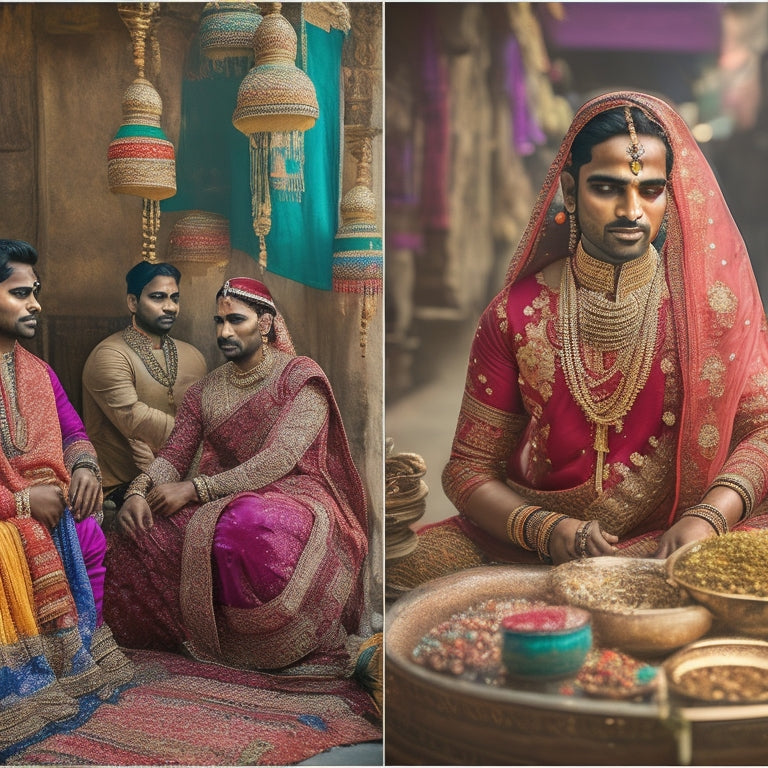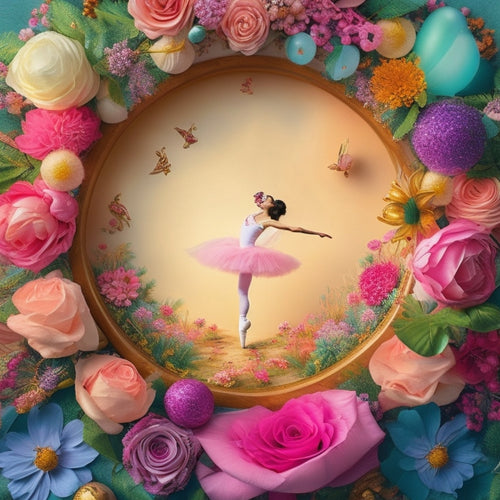
Traditional Indian Clothing Steeped in Culture
Share
When you investigate traditional Indian clothing, you uncover layers of cultural significance. Every fabric tells a story through intricate designs and lively colors, symbolizing regional beliefs and values. For instance, a Bandhani saree from Gujarat embodies joy, while a Phulkari dupatta signifies agricultural prosperity from Punjab. These garments don't just reflect style; they convey deep heritage and dignity. Additionally, handcrafted techniques and sustainable materials emphasize authenticity and support local artisans. Choosing the right attire for specific occasions enhances your connection to the culture, making every outfit a narrative waiting to be told. There's much more to learn about this rich tradition.
What You Need to Know
- Traditional Indian clothing reflects cultural heritage, with each garment narrating stories and symbolizing regional beliefs and values.
- Intricate fabric designs feature mythical motifs and color symbolism, conveying prosperity, love, and joy in their patterns.
- Regional variations in attire, such as Phulkari and Kantha, showcase unique artistic expressions and local histories across India.
- Handcrafted techniques in traditional clothing support artisan communities and promote sustainable fashion, preserving authenticity and reducing environmental impact.
- The choice of attire for occasions, like weddings and festivals, demonstrates respect for cultural traditions and enhances communal bonds.
Cultural Heritage in Every Stitch
When you investigate traditional Indian clothing, you'll notice that each fabric design carries deep symbolism, reflecting the rich narratives of different cultures.
The opulence of these garments often showcases luxurious silk and lively cotton, reminiscent of Bollywood costume aesthetics that blend cultural heritage with contemporary styles.
Regional variations showcase a stunning array of styles, each telling its own story through colors, patterns, and techniques.
Understanding these elements allows you to appreciate how each stitch connects to a broader cultural heritage.
Symbolism in Fabric Designs
Every intricate pattern and lively hue in traditional Indian fabrics tells a story steeped in cultural significance. When you wear these textiles, you're not just donning fabric; you're embracing centuries of history.
Mythical motifs, like elephants and peacocks, weave tales of prosperity, wisdom, and beauty. Each design choice reflects the region's beliefs and values, altering simple garments into lively narratives.
Color symbolism is equally significant, with shades chosen for their emotional and cultural resonance. For instance, red embodies love and passion, while yellow signifies knowledge and joy.
As you investigate these fabrics, you'll notice how each color and pattern invites you into a deeper understanding of the stories they carry.
The significance of these designs goes beyond mere aesthetics; they connect you with a rich heritage. By appreciating the symbolism in fabric designs, you're not only honoring tradition but also celebrating the freedom of expression that these textiles represent.
Each stitch is a reminder of the past, a bridge linking generations through the art of weaving. Ultimately, when you wear traditional Indian clothing, you're adorned in a mosaic of cultural heritage, rich with meaning and life.
Regional Variations and Styles
The rich fabric of traditional Indian clothing is woven with diverse regional variations that reflect the unique cultural heritage of each area. As you investigate these regional attires, you'll notice how cultural influences shape their designs, colors, and materials. Each region tells a story through its clothing, merging history with artistry.
| Region | Attire Example |
|---|---|
| Punjab | Phulkari Dupatta |
| Gujarat | Bandhani Saree |
| West Bengal | Kantha Stitch Saree |
In Punjab, the lively Phulkari dupatta, adorned with intricate embroidery, showcases the region's agricultural abundance and festive spirit. In Gujarat, the Bandhani saree's tie-dye patterns echo centuries-old traditions, symbolizing joy and celebration. Meanwhile, the Kantha stitch saree from West Bengal reflects the region's artisanal heritage, where each stitch narrates a tale of love and devotion.
These regional variations not only highlight the diversity of Indian attire but also serve as a canvas for cultural narratives. As you probe deeper, you'll appreciate how each piece of clothing connects you to its roots, offering a glimpse into the rich mosaic of India's cultural heritage.
Sustainable and Eco-Friendly Fashion
When you consider sustainable and eco-friendly fashion within the framework of traditional Indian clothing, the importance of using organic materials becomes clear.
These fabrics not only reduce environmental impact but also promote health and wellness for the wearer.
In addition to their eco-friendly benefits, body positivity encourages confidence and comfort in traditional attire.
Handcrafted techniques, often passed down through generations, add a layer of authenticity and artistry that mass-produced clothing simply can't match.
Organic Materials Usage
As consumers increasingly seek sustainable options, the use of organic materials in traditional Indian clothing has gained significant attention. You'll find that organic cotton, silk, and linen not only provide comfort but also promote fabric sustainability. These materials are grown without harmful pesticides or synthetic fertilizers, reducing environmental impact and supporting healthier ecosystems.
Employing natural dyes further enhances this eco-friendly approach. Derived from plants, minerals, and insects, these dyes create lively colors while avoiding the toxic chemicals used in conventional dyeing processes. By choosing garments dyed with natural substances, you're not just wearing a piece of art; you're contributing to a movement that prioritizes health and sustainability.
Incorporating organic materials into your wardrobe allows you to connect with the rich heritage of Indian textiles while embracing a modern ethos of environmental responsibility.
With each piece, you're not just making a fashion statement; you're making a conscious choice that reflects your values. As traditional Indian clothing evolves, the focus on organic materials signifies a shift towards a more sustainable future, blending centuries-old craftsmanship with contemporary eco-consciousness.
Handcrafted Techniques Importance
Handcrafted techniques play an essential role in sustainable and eco-friendly fashion, especially within the domain of traditional Indian clothing. When you choose handmade garments, you're not just making a fashion statement; you're supporting artisan communities that have honed their craft over generations.
These artisans often use age-old methods that require minimal machinery, which greatly reduces the carbon footprint associated with mass production. By embracing these techniques, you contribute to preserving cultural heritage while promoting sustainable practices.
Each piece tells a story—woven in intricate patterns and dyed with natural colors. This authenticity contrasts sharply with the fast fashion industry, which relies on synthetic materials and exploitative labor practices.
Moreover, handmade garments often incorporate locally sourced materials, ensuring that your choices help sustain local economies. The slower production process allows artisans to focus on quality over quantity, creating unique pieces that stand the test of time.
When you wear these garments, you're not just dressing yourself; you're embodying a commitment to sustainable fashion that respects both people and the planet. By choosing handcrafted techniques, you actively participate in a movement towards a more ethical and environmentally conscious world.
Textiles Reflect Regional Diversity
When you investigate traditional Indian textiles, you'll notice how the fabric varieties vary greatly from one region to another, each telling a unique story.
The intricate designs and lively colors often evoke a sense of rustic elegance, much like the earthy tones found in autumn decor.
These differences stem from traditional weaving techniques that have been passed down through generations, reflecting the local culture and resources.
Regional Fabric Varieties
Although you might think of Indian textiles as a single, cohesive tradition, they actually showcase a stunning array of regional fabric varieties that reflect the diverse cultural environments of the country. Each region boasts unique cotton varieties, from the soft, breathable fabrics of Gujarat to the rich, lively textures found in Tamil Nadu.
You'll also encounter silk traditions, like the luxurious Banarasi and Kanjivaram silks, which speak to the region's historical significance. In colder climates, wool craftsmanship becomes paramount, with artisanal shawls from Kashmir exemplifying intricate regional patterns and dyeing techniques.
The textile markets in Rajasthan are alive with bold colors and elaborate embroidery styles, each telling a story of the community's heritage. As you investigate these fabrics, understanding fabric care becomes essential to preserve their beauty and longevity.
You'll find that weaving communities across India aren't just creating textiles; they're weaving cultural influences into every thread. So, as you welcome these diverse fabrics, remember that each piece offers a glimpse into the rich mosaic of India's cultural scenery, inviting you to celebrate this freedom of expression through textiles.
Traditional Weaving Techniques
As you explore the rich fabric of traditional Indian weaving techniques, you'll uncover that each method not only showcases the skill of artisans but also embodies the cultural narratives of their respective regions.
The diversity in loom types plays a significant role in this artistic expression. For instance, the handloom, prevalent in states like Tamil Nadu and West Bengal, allows weavers to create intricate patterns and textures, reflecting local traditions and motifs.
Moreover, the dyeing methods employed in these regions further enhance the uniqueness of the textiles. Natural dyes derived from local flora are often used, imparting lively colors that tell stories of the land's heritage.
Techniques such as tie-dye in Rajasthan or the use of indigo in Gujarat not only reveal the creativity of local artisans but also their commitment to sustainability.
As you investigate deeper, you'll notice how these weaving techniques aren't merely about fabric; they're a celebration of cultural identity and regional honor.
Each piece woven on these looms carries with it the essence of its origin, connecting the wearer to a broader narrative that transcends time and geography.
Embracing these textiles means embracing freedom and diversity in expression.
Selecting Based on Occasion
When it comes to selecting traditional Indian clothing, the occasion plays a vital role in your choices.
For weddings and celebrations, you'll want to opt for rich fabrics and lively colors that reflect the joy of the event, while festivals and cultural gatherings may call for a blend of traditional flair and comfort.
Events organized by communities, such as those celebrated by BCS, highlight the importance of dressing in a way that honors cultural heritage.
Understanding these subtleties helps you dress appropriately and appreciate the significance of each occasion.
Weddings and Celebrations
Choosing the right traditional Indian attire for weddings and celebrations is vital, as it reflects the cultural significance and personal style of the wearer. Your choice of bridal attire or festive garments can impact how you connect with the rituals and traditions surrounding these joyous occasions.
| Occasion | Recommended Attire |
|---|---|
| Weddings | Elaborate bridal lehengas, accompanied by traditional jewelry. |
| Engagements | Stylish sarees or anarkalis, often featuring heirloom pieces. |
| Festivals | Lively kurta sets or festive salwar kameez, showcasing regional motifs. |
When selecting ceremonial dress, consider color symbolism; reds and golds often signify prosperity and happiness. Outfit coordination is important as well, especially for family members, to create a harmonious look during the wedding rituals. Traditional jewelry complements these outfits, adding an extra layer of sophistication and cultural depth.
Festivals and Cultural Events
For festivals and cultural events, selecting traditional attire involves understanding the significance of the occasion and the message you want to convey. Each festival in India carries its own cultural weight, and your choice of festive attire can reflect personal beliefs and societal values.
For instance, during Diwali, lively saris or kurtas adorned with intricate embellishments symbolize prosperity and light, while during Holi, white garments serve as a canvas for colorful powders, embodying joy and unity.
Consider the regional variations, too. In Punjab, you might opt for a phulkari dupatta, celebrating the rich agricultural heritage, while in West Bengal, a traditional tant saree speaks to the artistry of handwoven textiles.
This conscious selection not only pays homage to cultural significance but also allows you to express individuality within communal traditions.
The essence of traditional clothing lies in its ability to bridge the past with the present. So, when you dress for a festival or cultural event, remember that your attire is more than just fabric; it's a statement of identity, heritage, and a celebration of the lively fabric that's Indian culture.
Timeless Craftsmanship and Artistry
When you investigate traditional Indian clothing, you can't overlook the significance of handwoven textiles that reflect a rich heritage.
These fabrics often incorporate cultural storytelling elements, showcasing intricate techniques passed down through generations, revealing the artistry of skilled artisans.
As you appreciate these fabrics, you'll notice how their unique patterns and textures embody both cultural identity and timeless craftsmanship.
Handwoven Textile Heritage
Handwoven textiles in India reflect a rich fabric of culture, tradition, and artisanal skill that has evolved over centuries. Each piece tells a story, intricately woven with the threads of history, community, and identity. You'll find that these textiles aren't just fabric; they're a testament to the heritage preservation efforts that keep age-old techniques alive.
The artistry involved in handloom weaving is a dance of creativity and precision, where every design element holds significance.
Moreover, this craft is a powerful driver of community advancement. By supporting local artisans, you're contributing to the sustainability of their craft and the economic upliftment of their communities. Each purchase you make can help preserve traditional skills that might otherwise fade into obscurity.
As you investigate handwoven textiles, you're not just acquiring a unique piece of clothing; you're participating in a cultural movement that values authenticity and individuality. With every woven thread, you're supporting a narrative that champions freedom of expression and the preservation of diverse cultural identities.
Welcome this heritage, and let it inspire your personal style while nurturing a deeper connection to the artisans behind the craft.
Frequently Asked Questions
What Are the Most Popular Colors in Traditional Indian Clothing?
In traditional Indian clothing, bright colors like red, yellow, and green hold deep cultural significance. Each hue symbolizes emotions and values, reflecting beliefs and traditions. You'll find these colors express joy, purity, and prosperity.
How Has Globalization Impacted Traditional Indian Attire?
Globalization's reshaped your viewpoint on attire, blending cultural fusion with fashion evolution. You see lively styles merging, as traditional garments adapt to modern influences, creating unique expressions that celebrate both heritage and contemporary identity.
What Accessories Complement Traditional Indian Outfits?
To complement traditional outfits, you'll find jewelry trends like intricate bangles and statement earrings enhance your look. These accessories carry cultural significance, marrying style with heritage, allowing you to express identity and celebrate your roots.
Are There Specific Fabrics Associated With Different Regions of India?
Yes, you'll find specific regional textiles throughout India, each with cultural significance. Fabrics like Banarasi silk from Varanasi or Kanchipuram silk from Tamil Nadu showcase distinct weaving techniques, colors, and motifs reflective of their origins.
How Do Climate Conditions Affect Traditional Indian Clothing Choices?
Climate shapes your clothing choices like a sculptor molds clay. You adapt fabrics to seasonal variations, ensuring comfort and style. In hot regions, you favor breathable materials, while cooler climates call for warmer, layered options.
Explore More
In the lively fabric of traditional Indian clothing, you're not just wearing fabric; you're draping yourself in centuries of cultural history. Each piece tells a story, reflecting the diverse regions and skilled craftsmanship that define India's rich heritage. By choosing sustainable options and selecting attire based on occasion, you're not only making a fashion statement but also preserving a legacy that's as vast as the ocean. Welcome this cultural treasure and let your wardrobe celebrate the past while shaping the future.
Related Posts
-

3 Essential Tools for Dance Makeup Artists Online
As a dance makeup artist, you already possess the skills to create stunning looks, and with the right digital tools, ...
-

The King Manual: Your Ultimate Knowledge Companion
The King Manual: Your Ultimate Knowledge Companion is an all-encompassing resource that opens up the power of knowled...
-

Ballet Cut File Set: Versatile Designs Available
The Ballet Cut File Set offers a wide-ranging collection of versatile designs available in multiple formats, includin...


